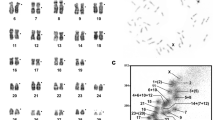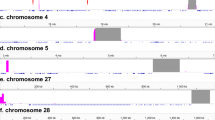Abstract.
Human Chromosome 19 (HSA19) is virtually completely sequenced. A complete physical contig map made up of BACs and cosmids is also available for this chromosome. It is, therefore, a rich source of information that we have used as the basis for a comparative mapping study with the chicken. Various orthologs of genes known to map to HSA19 have been mapped in the chicken. Five chicken microchromosomes (two of which were previously undefined) are seen to show conserved synteny with this chromosome, along with individual gene homologs on Chr 1 and another tiny microchromosome. Compared with the mouse, which has 12 chromosomal regions homologous to HSA19, the chicken genotype displays fewer evolutionary rearrangements. The ancestral nature of the chicken karyotype is demonstrated and may prove to be an excellent tool for studying genome evolution.
Similar content being viewed by others
Author information
Authors and Affiliations
Rights and permissions
About this article
Cite this article
Smith, J., Paton, I., Murray, F. et al. Comparative mapping of human Chromosome 19 with the chicken shows conserved synteny and gives an insight into chromosomal evolution . Mammalian Genome 13, 310–315 (2002). https://doi.org/10.1007/s00335-001-3071-1
Received:
Accepted:
Published:
Issue Date:
DOI: https://doi.org/10.1007/s00335-001-3071-1




